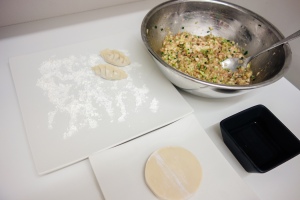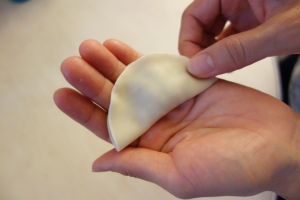
Homemade Japanese Gyozas
Share
Want to eat Gyozas at home?
I know you French love it! The problem is that it seems complicated to do, but don't worry I explain everything here with photos. You will see that it is not that difficult. It’s even great fun to do with your family or guests. You will be a Gyoza master by the end of this recipe :)
Ingredients: approximately 100 pieces of Gyoza / for 10 people
(You can freeze some if the quantity is too large)
• 500g of sausage meat
• 500g of vegetables
– 10 stalks of garlic leaf* (or 3 stalks of spring onions)
– 8 Chinese cabbage leaves (approximately)
• 20g of pureed ginger
• 20g chopped garlic: 3 cloves of garlic
• 3 tablespoons of oyster sauce*
• 3 tbsp of white wine
• 3 tablespoons of soy sauce
• 3 tbsp sesame oil
• 100 sheets of Gyoza dough* to form the ravioli.
• Potato starch (Katakuriko) / or corn (Maïzena)
Preparation
Cut the vegetables into very small pieces.
The joke
In a salad bowl, mix the sausage meat well.
First add all the liquid ingredients, then add all the vegetables (ginger, garlic, Chinese cabbage, garlic leaf) and mix well.
Shaping the ravioli
Prepare
– A bowl of cold water within reach.
– Plates sprinkled with potato starch.
1. Take a sheet of dough in the palm of your hand and place a good teaspoon of stuffing in the center of the sheet.
2. Moisten the edge of the pastry sheet well with your index finger.
3. Fold in half, close tightly with your fingers.
Pinch and make a small fold in the middle.
4. Make the second fold on the left, and the third on the right.
Place on a plate sprinkled with starch.
The more folds, the more beautiful your ravioli will be.
To cook these Gyozas, click on the link.
What is this ?
Garlic leaf*
A wild plant that goes by many names: wild garlic, wild garlic, broad-leaved garlic, petiolate garlic. It was widely used in Europe and Asia. You can eat its bulb and leaves as a vegetable or condiment. It is excellent raw in salads.
(link to Wikipedia)
You can find them in Chinese, Japanese or Korean grocery stores.
Oyster sauce*
A very popular condiment in Asia.
Its subtle taste, both sweet and salty, flavors a large number of dishes: meats, poultry, fish, seafood, vegetables, stir-fried noodles and rice.
(link to Wikipedia)
You can find them in Chinese, Japanese or Korean grocery stores.
Gyoza dough sheets*
Ravioli dough with wheat flour and potato (or corn) starch
You can find them in Chinese, Japanese or Korean grocery stores.










